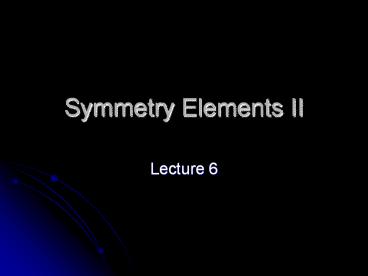Symmetry Elements II - PowerPoint PPT Presentation
Title:
Symmetry Elements II
Description:
Symmetry Elements II Lecture 6 3-D Symmetry We now have 8 unique 3D symmetry operations: 1 2 3 4 6 m 3 4 Point Group The set of symmetry operations ... – PowerPoint PPT presentation
Number of Views:292
Avg rating:3.0/5.0
Title: Symmetry Elements II
1
Symmetry Elements II
- Lecture 6
2
3-D Symmetry
- We now have 8 unique 3D symmetry operations
- 1 2 3 4 6 m 3 4
Combinations of these elements are also
possible A complete analysis of symmetry about a
point in space requires that we try all possible
combinations of these symmetry elements
3
Point Group
- The set of symmetry operations that leave the
appearance of the crystal structure unchanged. - There are 32 possible point groups(i.e., unique
combinations of symmetry operations).
4
2-D Symmetry
- Try combining a 2-fold rotation axis with a
mirror - The result is Point Group 2mm
- 2mm indicates 2 mirrors
- The mirrors are different
5
2-D Symmetry
- Now try combining a 4-fold rotation axis with a
mirror
6
2-D Symmetry
- Now try combining a 4-fold rotation axis with a
mirror - Step 1 reflect
7
2-D Symmetry
- Now try combining a 4-fold rotation axis with a
mirror - Step 1 reflect
- Step 2 rotate 1
8
2-D Symmetry
- Now try combining a 4-fold rotation axis with a
mirror - Step 1 reflect
- Step 2 rotate 2
9
2-D Symmetry
- Now try combining a 4-fold rotation axis with a
mirror - Step 1 reflect
- Step 2 rotate 3
10
2-D Symmetry
- Now try combining a 4-fold rotation axis with a
mirror
Any other elements?
11
2-D Symmetry
- Now try combining a 4-fold rotation axis with a
mirror
Any other elements?
Yes, two more mirrors
12
2-D Symmetry
- Now try combining a 4-fold rotation axis with a
mirror
Any other elements?
Yes, two more mirrors
Point group name??
13
2-D Symmetry
- Now try combining a 4-fold rotation axis with a
mirror
Any other elements?
Yes, two more mirrors
Point group name??
4mm
Why not 4mmmm?
14
2-D Symmetry
- 3-fold rotation axis with a mirror creates point
group 3m - Why not 3mmm?
15
2-D Symmetry
- 6-fold rotation axis with a mirror creates point
group 6mm
16
2-D Symmetry
- The original 6 elements plus the 4 combinations
creates 10 possible 2-D Point Groups - 1 2 3 4 6 m 2mm 3m 4mm 6mm
- Any 2-D pattern of objects surrounding a point
must conform to one of these groups
17
3-D Symmetry
- As in 2-D, the number of possible combinations is
limited only by incompatibility and redundancy - There are only 22 possible unique 3-D
combinations, when combined with the 10 original
3-D elements yields the 32 3-D Point Groups
18
3-D Symmetry
- The 32 3-D Point Groups
- Every 3-D pattern must conform to one of them.
- This includes every crystal, and every point
within a crystal
Table 5.1 of Klein (2002) Manual of Mineral
Science, John Wiley and Sons
19
Crystal Systems
- A grouping point groups that require a similar
arrangement of axes to describe the crystal
lattice. - There are seven unique crystal systems.
20
3-D Symmetry
- The 32 3-D Point Groups
- Regrouped by Crystal System
Table 5.3 of Klein (2002) Manual of Mineral
Science, John Wiley and Sons
21
Triclinic
- Three axes of unequal length
- Angles between axes are not equal
- Point group 1
22
Monoclinic
- Three axes of unequal length
- Angle between two axes is 90
- Point groups 2, m, 2/m
23
Orthorhombic
- Three axes of unequal length
- Angle between all axes is 90
- Point groups 2222/m2/m/2/m, 2mm
24
Tetragonal
- Two axes of equal length
- Angle between all axes is 90
- Point groups 4, 4, 4/m, 4mm, 422, 42m, 4/m2/m2/m
25
Hexagonal
- Four axes, three equal axes within one plane
- Angle between the 3 co-planar axes is 60
- Angle with remaining axis is 90
- Point groups 6, 6, 6/m, 6mm, 622, 62m, 6/m2/m2/m
26
Trigonal (Subset of Hexagonal)
- Four axes, three equal axes within one plane
- Angle between the 3 co-planar axes is 60
- Angle with remaining axis is 90
- Point groups 3, 3, 3/m, 32, 32/m
27
Cubic / Isometric
- All axes of equal length
- Angle between all axes is 90
- Point groups 23, 423, 2/m3, 43m, 4/m32/m
28
Crystal System Characteristics
- Isometric/Cubic
- Hexagonal
- Tetragonal
- Orthorhombic
- Monoclinic
- Triclinic
ALL AXES EQUAL
AXES UNEQUAL
29
Birefringence
- Isometric/Cubic
- Hexagonal
- Tetragonal
- Orthorhombic
- Monoclinic
- Triclinic
ISOTROPIC
ANISOTROPIC
30
Crystal System Characteristics
- Isometric/Cubic
- Hexagonal
- Tetragonal
- Orthorhombic
- Monoclinic
- Triclinic
ALL AXES EQUAL
TWO AXES EQUAL
ALL AXES UNEQUAL
31
Interference Figure
- Isometric/Cubic
- Hexagonal
- Tetragonal
- Orthorhombic
- Monoclinic
- Triclinic
UNIAXIAL
BIAXIAL
32
Crystal System Characteristics
- Isometric/Cubic
- Hexagonal
- Tetragonal
- Orthorhombic
- Monoclinic
- Triclinic
ALL AXES EQUAL
AXES ORTHOGONAL
AXES NON-ORTHOGONAL
33
Extinction
- Isometric/Cubic
- Hexagonal
- Tetragonal
- Orthorhombic
- Monoclinic
- Triclinic
PARALLEL
INCLINED































